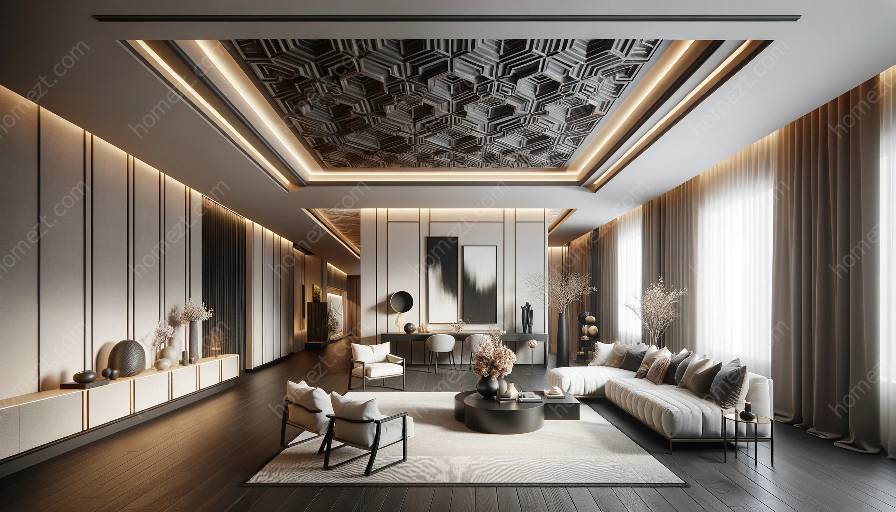Statement ceilings have become a popular interior design trend, adding character and enhancing the aesthetics of a space. However, when it comes to creating a statement ceiling, considering the impact of climate and location is crucial to ensure both visual appeal and functionality.
Climate and location can significantly influence the design, material choice, and structural considerations for statement ceilings. Let's explore how these factors play a role in creating captivating and practical ceiling designs that harmonize with their surroundings.
1. Climate-Inspired Statement Ceilings
Climate has a profound impact on architectural styles and building materials used in a region. When designing statement ceilings, incorporating climate-inspired elements can not only enhance the visual appeal but also contribute to the comfort and efficiency of the space.
A. Warm and Humid Climates
In regions with warm and humid climates, considerations for ventilation and heat dissipation are essential. Statement ceilings in such locations can benefit from open and airy designs, allowing for better airflow and heat distribution. Additionally, lightweight and moisture-resistant materials, such as bamboo or natural fibers, can be used for ceiling finishes, enabling better moisture management and reducing the risk of mold and mildew.
B. Cold and Harsh Climates
In colder climates, the focus shifts towards insulation and energy efficiency. Statement ceilings can incorporate thermal insulation materials and strategic designs to minimize heat loss and reduce energy consumption. Wood or composite panels with insulating properties can be employed to create visually striking yet thermally efficient ceilings that help maintain a comfortable indoor environment.
C. Coastal and Windy Environments
Coastal and windy locations pose unique challenges such as saltwater exposure and strong winds. When crafting statement ceilings in these areas, using durable and corrosion-resistant materials like aluminum, stainless steel, or specially treated wood can ensure longevity and resistance to environmental effects. Additionally, designing aerodynamic ceiling features can help mitigate wind pressure and enhance the structural integrity of the ceiling.
2. Location-Integrated Statement Ceilings
Local traditions, architectural styles, and cultural influences play a pivotal role in shaping the design language of a region. Statement ceilings that integrate with the local context can evoke a sense of place and create a cohesive visual narrative within the space.
A. Historical and Heritage Sites
When working on statement ceiling designs in historical or heritage sites, respecting the architectural heritage and preserving the original character is paramount. Traditional ornamentation, such as coffered ceilings, exposed wooden beams, or decorative plasterwork, can be incorporated to honor the historical significance while adding a touch of grandeur to the space.
B. Urban and Contemporary Settings
In urban environments characterized by sleek and modern architecture, statement ceilings can reflect the contemporary aesthetic through minimalist designs, clean lines, and innovative materials. Utilizing metallic finishes, geometric patterns, or modular ceiling systems can align with the urban ambiance while adding a distinctive flair to the interior space.
C. Rural and Vernacular Architecture
For spaces nestled within rural or vernacular settings, statement ceilings that embrace local craftsmanship and traditional building techniques can seamlessly blend with the surroundings. Exposed timber framing, thatched roofing, or adobe-inspired textures can be integrated into the ceiling design, echoing the vernacular charm and creating a warm, inviting atmosphere.
3. Decorating Statement Ceilings with Contextual Elements
Decorative elements on statement ceilings can further emphasize the relationship between climate, location, and design, enhancing the overall aesthetic impact and storytelling potential of the space.
A. Natural Elements and Biophilic Design
Incorporating natural elements such as wooden slats, plant-inspired patterns, or skylights can introduce biophilic design principles to statement ceilings, fostering a connection with nature and promoting a sense of well-being. This approach can be particularly effective in locations where the surrounding natural environment and greenery play a prominent role in shaping the local identity.
B. Cultural Motifs and Symbolism
Embracing cultural motifs, indigenous artwork, or symbolic references in statement ceiling designs can pay homage to the heritage and traditions of the location. By integrating cultural symbolism into the ceiling decor, the space becomes a storytelling canvas that resonates with the local community and enriches the interior narrative with depth and significance.
C. Sustainable and Eco-Friendly Applications
In alignment with the climate-conscious ethos, statement ceiling decorations can incorporate eco-friendly materials, energy-efficient lighting, and sustainable design practices to demonstrate a commitment to environmental responsibility. This approach not only aligns with the geographical context but also communicates a forward-thinking and socially conscious ethos to the occupants and visitors.
Conclusion
Considering the impact of climate and location on statement ceiling design is essential for creating rich, contextual, and visually compelling interior spaces. By harmonizing architectural responses with environmental factors and cultural nuances, statement ceilings can transcend their ornamental function and become meaningful expressions of local identity, sustainability, and design innovation.






































